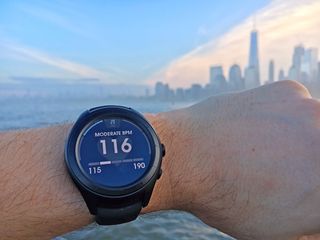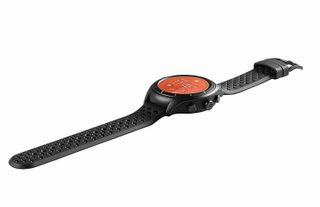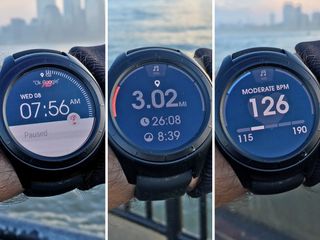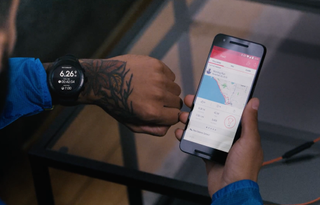New Balance RunIQ Smartwatch Review: Not a Good Running Partner
New Balance’s Android Wear-powered RunIQ smartwatch trips over its limited features, poor interface and short battery life.
Why you can trust Tom's Guide

My first GPS-enabled watch was the New Balance Runner 1K2. Like other early-model GPS watches, the Runner 1K2 took a long time to find a signal, especially on cloudy days, and it couldn’t sync with a smartphone or a third-party website to store and track run data.
About five years later, New Balance — a brand known for producing some of the best running shoes — is back with the $299 RunIQ watch, a fitness-centric Android Wear smartwatch that boasts GPS, smartphone notifications and a heart-rate monitor.
But newer isn’t always better. My old reliable 1K2 watch displayed distance, pace and elapsed time in real time as I ran, it stored data for up to 30 runs at a time and its battery lasted days between charges. The RunIQ doesn’t do any of those things, which means you should check out other GPS running watches on our best-picks list.
Design
With three buttons along the right side and a replaceable 22-millimeter (0.87 inches) silicone band, the RunIQ looks like a running watch. Measuring 45 mm (1.78 inches) across and weighing more than 2.6 ounces, it feels like a running watch, too.

The RunIQ fits comfortably, though, because the optical heart-rate monitor (HRM) is embedded in the watch and doesn’t stick into your wrist. That’s a step up from the Polar M600, where the HRM sticks out quite a bit and the watch slides around on your wrist during a workout.
The top button on the RunIQ starts or pauses a run, the bottom button starts a new lap, and the middle button is the main on and back button. The RunIQ offers a touch screen, which is almost a must-have for smartwatches today. The controls are straightforward: You swipe right to open the main menu, up to open notifications and left to dismiss notifications. The screen can be unresponsive, though; on more than one occasion, I needed to press the screen several times to start a run.

The watch is water-resistant to 5 ATM, meaning it will withstand a sudden downpour and is suitable for taking into a pool, though the RunIQ does not track swimming.
Setup and Apps
The RunIQ runs Android Wear OS, which is compatible with Android smartphones running version 4.3 or higher of the mobile operating system. The RunIQ is also one of a handful of watches that will run Android Wear 2.0, though the timing of the update has yet to be announced.
I tested the RunIQ with a 16GB Samsung Galaxy S5. The watch is also compatible with the iPhone, but this limits its smartwatch capabilities.
The setup involves charging the watch, downloading Android Wear onto your phone, pairing the watch with your phone, and downloading two smartphone apps: MyNB and Strava.
MORE: Best Fitness Trackers for Running, Swimming and Training
MyNB will manage the basic settings of the watch, such as your watch face and your music playlists. It will also connect you to local New Balance stores and their affiliated running groups, and shows you educational articles on post-run recovery and cross-training. As you use the app, you earn points that you can redeem for New Balance merchandise.

Mostly, though, MyNB seems to be a marketing app for New Balance shoes and apparel; once my watch settings were right, I stopped using the app.
Strava, on the other hand, will manage all of your run data. Watchmakers such as Epson and Polar could learn a lesson here and scrap their poorly designed proprietary apps for an established app with a large user base and a good interface. Strava integration also allows iPhone users to track their runs.
However, if you rely solely on Strava to save your run data, you’ll need to use two apps with the RunIQ. What’s worse, you can’t get to your Strava account from the MyNB app. This makes for a confusing user experience.
Daily Use
When paired with Android Wear, the RunIQ behaves much like the Polar M600 and the Moto 360 Sport. You can receive all of your smartphone notifications — text message, email, social media, events and even work apps such as Slack — on the watch itself. The watch is Wi-Fi-enabled, so you can receive notifications when your smartphone is out of Bluetooth range, though this feature will automatically shut off if the watch battery gets too low.
MORE: Fitness Tracker Buying Guide
Through Google Now, you can use voice commands to reply to messages. (Apple users can receive notifications on the RunIQ but cannot reply to them.) Verizon customers can also install a smartphone app that pairs the RunIQ with their Verizon account. Finally, you can use the RunIQ to initiate a phone call on your smartphone. Overall, the RunIQ’s smartwatch features work smoothly, which is what you would expect from an Android Wear watch.
Running Use
The process of starting a run on the RunIQ is straightforward. You tap the display once, and then tap the activity icon and wait for the watch to find a GPS signal. Once you get a signal, you just tap the screen one more time and go. The RunIQ tracks only runs or bicycle rides, which is far fewer activity types than the Polar M600 or the Moto Sport 360 can track.

Android Wear does let you add additional fitness apps, but very few of these track additional activities, such as swimming or skiing.
One morning, I grabbed the watch from my nightstand, and it had somehow logged about 350 steps in the middle of the night even though I didn’t wear the watch to sleep.
Through the MyNB app, the RunIQ pairs with Google Play Music, which allows you to control your playlists and store up to 50 hours of music on the watch itself. For another $110, you can get NB PaceIQ Earbuds, which are New Balance-branded Jabra headphones that integrate with RunIQ.
Nevertheless, the RunIQ is a bad running watch. There are several reasons why.
- Kilometers are the default unit on the watch, and you change this not through the watch settings on MyNB but through the Strava settings on the watch. (Oddly, my run distances showed up as miles in Strava before I changed the units on my watch.)
- You can see the RunIQ watch face at dawn or dusk, but on the default brightness setting (2 out of 5), it’s barely visible in direct sunlight. If you want to see anything, you need to tap the screen or shake your wrist. Admittedly, the Polar M600 is the same way; this flaw is common to Android Wear watches.
- The watch will vibrate at every kilometer, but the display will be lit for only a few seconds, and the RunIQ will not provide any additional info — no heart rate, elapsed time or even a split time. (Again, my splits, measured per mile, showed up in Strava.)
- The main screen of the RunIQ displays time, distance and pace — but this information isn’t updated in real time. If you want to see it, you need to shake your wrist. If you don’t, the watch updates the information every 60 seconds. If you monitor your pace regularly, or you do short interval workouts, the watch isn’t at all useful.
- Although the watch will calculate and display heart-rate data, cadence and lap data while you run, you need to swipe on the watch face to see that information. You also need to swipe three times and then press the Lap button to start a new lap. This is clumsy, if not unsafe.
- Even though the watch gathers heart-rate and cadence data, it isn’t included in the summary data that appears at the end of a run. Instead, you see only distance, time and pace. The Polar M600 (or pretty much every other running watch, for that matter), by contrast, does show the heart-rate and cadence data.
On top of all that, the RunIQ step counter wasn’t very accurate in my tests. One morning, I grabbed the watch from my nightstand, and it had somehow logged about 350 steps in the middle of the night even though I didn’t wear the watch to sleep. On another occasion, the step counter did not reset at midnight. In my time testing nearly a dozen watches and fitness trackers, that has never happened to me. However, a company representative said this bug was fixed with a software update.
As with most wrist-based heart-rate monitors, the HRM in the RunIQ proved less accurate than a chest-strap Polar H7. On a 7-mile run, the H7 measured an average heart rate of 148 beats per minute and a maximum heart rate of 171 bps, compared with an average of 139 bpm and a maximum of 184 bpm on the RunIQ. The reason? At a number of points during the run — including during two of my fastest miles and while I was running up a hill with a 7 percent grade — the RunIQ measured a heart rate of less than 90 beats per minute, which brought the overall average down.
Battery Life
According to New Balance, the RunIQ’s 410-mAh battery can last about 24 hours with typical use and 5 hours with continuous use (GPS and HRM).
After putting the fully charged watch on first thing in the morning, wearing it all day with all notifications on, and going for a 40-minute run, the battery was below 20 percent at bedtime, which is broadly consistent with the manufacturer’s specs. Considering that the watch doesn’t track sleep, taking it off and charging it every night probably wouldn’t be a big deal.
The RunIQ needs about 90 minutes to come to a full charge. A magnet in the charging cradle keeps the watch in place and lets you set the watch on a flat surface while it’s charging. The cradle uses a standard Android USB cord, which means the same cord that charges your phone or tablet can also charge the watch.
Bottom Line
The RunIQ is branded as an “innovative collaboration” among Android Wear, computer chipmaker Intel, and Strava, but it falls far short of those high expectations. It offers the same standard smartwatch features as the Polar M600 and the Moto 360 Sport, only with a more confusing user experience and inexplicably poor running features.

After wearing the RunIQ for a couple of days, I missed my old 1K2. Sure, that watch couldn’t show me text messages or social media notifications, but it would at least tell me my pace whenever I looked at it. I can’t say the same for the RunIQ. Although they don’t include all of the smartwatch features in the RunIQ, the TomTom Spark 3 Cardio and the Garmin Forerunner 235 are better options for athletes; both of those devices track more activities, have better apps and last longer on a charge..
Sign up to get the BEST of Tom’s Guide direct to your inbox.
Upgrade your life with a daily dose of the biggest tech news, lifestyle hacks and our curated analysis. Be the first to know about cutting-edge gadgets and the hottest deals.
Brian Eastwood is a freelance writer for Tom’s Guide, focusing primarily on running watches and other wearable tech. Brian has been a professional writer and editor since 2003. He has covered healthcare tech, enterprise tech, higher education, and corporate leadership for a range of trade publications. Brian is a lifelong Massachusetts native and currently lives outside of Boston. Outside of work, he enjoys running, hiking, cross-country skiing, and curling up with a good history book.

